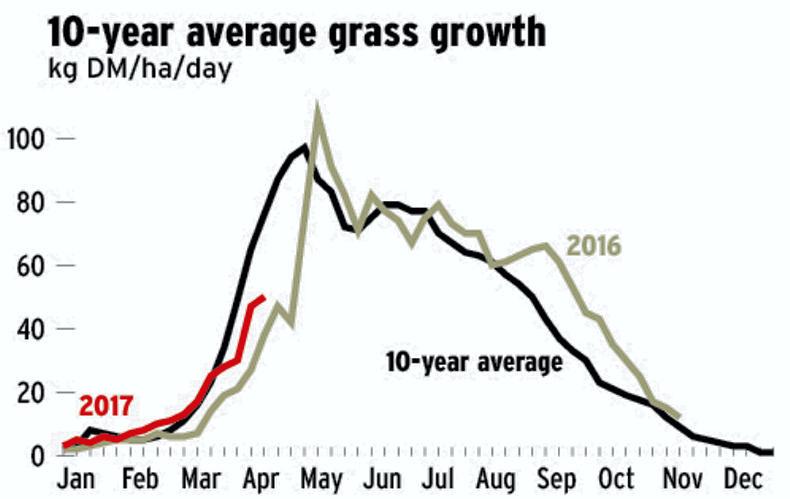Our measuring farms grew an average of 45kg DM/ha daily this week, ranging from 15 to 59kg DM/ha/day. This figure is slightly back on the 10-year average for the week and ahead of last year, when growth rates were initially slow, but doubled in just seven days in May, leading to grass quality headaches.
Now is the time to keep tabs on grass quality. Believe it or not, there are plenty of farms taking out paddocks already. While the nights are still cold and grass hasn’t really had a chance to kick on, growth rates are still high enough to service daily demand on most farms. A 45kgDM/ha/day growth rate will be matching demand exactly on a farm stocked at 2.5LU/ha.
We want our cattle grazing grass when it hits the three-leaf stage, soon after this the leaves begin to die and the ratio of stem-to-leaf increases. Stemmy grass contains 20% less energy for the animal than leafy material.
The next time you move cattle, pull up some grass plants from the new paddock. Are there three green, healthy leaves present?
Next week, in the final page of our grassland management Farmer Know-How series, we look at remedies for farms with too much or too little grass at the moment. The previous two editions of the Irish Farmers Journal contain step-by-step guides on actually measuring the farm.
At the moment. we should have 12-14 days’ worth of grass on the farm – meaning if growth were to cease, we could keep cattle fed for a fortnight. At current growth rates, a grass plant will be producing a new leaf every seven days after a tight grazing – so we should be aiming to leave a paddock and be back in 21 days later.
Rate of new leaf appearance depends on grass growth and we aim to stretch our rotation in slower growth periods and likewise reduce it by removing paddocks when growth accelerates.
![]()

Co Cork
System: suckler to bull beef
Soil: relatively dry
Avg farm cover (kg DM/ha): 775
Grass growth (kg DM/ha/day): 29
My stocking rate is below optimum level at the moment, so I have closed up extra ground for silage. All silage is baled here, so I can take out paddocks as required or go back in and graze them if I run short. I find this way I keep quality in the silage and am flexible with the amount of grass I have. I tend to spread only 50 to 60 units of N per acre on these paddocks and cut at four to five weeks. My bulls are nearly finished under 16 months and should average 380kg.
I will change my Angus bull after this year and aim for a bull with better terminal characteristics, to increase carcase weight. I have bought in over 90 calves this year to increase output and 18 yearlings. Some of these calves will be sold live at the end of the year and more will be kept on to next year to store or finish. The purchased yearlings will be finished off grass and I am aiming for a 300kg carcase with ration fed for the final six weeks.

Co Kilkenny
System: suckler to weanling
Soil: mostly heavy
Avg farm cover (kg DM/ha): 839
Grass growth (kg DM/ha/day): 59
There is plenty of grass on farm at the moment, as demand is quite low – cows are not due to calve until 10 July and are being restricted. I’ve taken my chance to spray off 15 acres for reseeding. Last year’s spring-born weanlings have been out on/off since the end of January and full-time since late-March. I targeted them towards silage ground and they worked through it well. Autumn-born weanlings were given access to paddocks during March, weaned at the end of the month and are now running separately.
All cows were given dry-cow tubes post-weaning, as there was an issue last year with mastitis. Silage ground has been closed nearly two weeks at this stage. It received three bags of 18-6-12, a bag of urea and 1,500 gallons of slurry per acre. Any surplus grass over the coming weeks will be taken off as silage, in order to keep quality in the sward.

Newford Herd, Co Galway
System: suckler to steer beef
Soil: dry to heavy
Avg farm cover (kg DM/ha): 1,115
Grass growth (kg DM/ha/day): 77
The second rotation began on the home farm on 6 April. Current daily grass demand is 49kg DM/ha and this is the first week that we’re building grass supply – the magic day has come. All of our silage ground is now closed and, as the regrowth was too heavy for slurry, it got two bags of urea and one bag of 0-7-30 per acre.
In all, 103 cows have now calved, with 106 calves on the ground, equating to 92% of the herd. Of these, 102 are grazing. Average calf weight thus far has been 43kg, and 91% of the herd was assigned a calving score of 1 (no assistance) or 2 (slight assistance).
Breeding is starting next Monday, and there is a lot of heat activity in the fields, thankfully. Cows are tail-painted, and we are recording heats at the moment. They also got their leptospirosis vaccination and a mineral bolus. The two teaser bulls are arriving this week. They are blood tested, vaccinated and will be kept in quarantine until breeding.

Co Clare
System: suckler to store
Soil: variable
Avg farm cover (kg DM/ha): 1,145
Grass growth (kg DM/ha/day): n/a
We’ve yet to get the big spurt in growth down here, and I’ve about 10 days of grass ahead of my cows and calves on the outfarm. I’m going in straightaway with a bag and a half of 18-6-12 on grazed paddocks. I’ll be sticking with the P and K for the next couple of rounds, to work on soil fertility. All grazing ground got 23 units of nitrogen in the form of urea on 11 February. All stock have been out at grass since the end of March, and cattle are cleaning paddocks off nicely.
Silage ground has been closed since 10 April. I managed to get 2,500 gallons/acre of slurry on one of the silage fields. This ground subsequently got a bag of 0-7-30 and 90 units of nitrogen. Silage ground that didn’t get slurry received two bags of 0-7-30 and 90 units of nitrogen. I’m putting a big emphasis on cutting top-quality silage this year for my autumn-calvers, and I pushed hard to get all silage ground grazed off before closing.

Read more
Grass+ dairy: growth rates good and steady
Our measuring farms grew an average of 45kg DM/ha daily this week, ranging from 15 to 59kg DM/ha/day. This figure is slightly back on the 10-year average for the week and ahead of last year, when growth rates were initially slow, but doubled in just seven days in May, leading to grass quality headaches.
Now is the time to keep tabs on grass quality. Believe it or not, there are plenty of farms taking out paddocks already. While the nights are still cold and grass hasn’t really had a chance to kick on, growth rates are still high enough to service daily demand on most farms. A 45kgDM/ha/day growth rate will be matching demand exactly on a farm stocked at 2.5LU/ha.
We want our cattle grazing grass when it hits the three-leaf stage, soon after this the leaves begin to die and the ratio of stem-to-leaf increases. Stemmy grass contains 20% less energy for the animal than leafy material.
The next time you move cattle, pull up some grass plants from the new paddock. Are there three green, healthy leaves present?
Next week, in the final page of our grassland management Farmer Know-How series, we look at remedies for farms with too much or too little grass at the moment. The previous two editions of the Irish Farmers Journal contain step-by-step guides on actually measuring the farm.
At the moment. we should have 12-14 days’ worth of grass on the farm – meaning if growth were to cease, we could keep cattle fed for a fortnight. At current growth rates, a grass plant will be producing a new leaf every seven days after a tight grazing – so we should be aiming to leave a paddock and be back in 21 days later.
Rate of new leaf appearance depends on grass growth and we aim to stretch our rotation in slower growth periods and likewise reduce it by removing paddocks when growth accelerates.
![]()

Co Cork
System: suckler to bull beef
Soil: relatively dry
Avg farm cover (kg DM/ha): 775
Grass growth (kg DM/ha/day): 29
My stocking rate is below optimum level at the moment, so I have closed up extra ground for silage. All silage is baled here, so I can take out paddocks as required or go back in and graze them if I run short. I find this way I keep quality in the silage and am flexible with the amount of grass I have. I tend to spread only 50 to 60 units of N per acre on these paddocks and cut at four to five weeks. My bulls are nearly finished under 16 months and should average 380kg.
I will change my Angus bull after this year and aim for a bull with better terminal characteristics, to increase carcase weight. I have bought in over 90 calves this year to increase output and 18 yearlings. Some of these calves will be sold live at the end of the year and more will be kept on to next year to store or finish. The purchased yearlings will be finished off grass and I am aiming for a 300kg carcase with ration fed for the final six weeks.

Co Kilkenny
System: suckler to weanling
Soil: mostly heavy
Avg farm cover (kg DM/ha): 839
Grass growth (kg DM/ha/day): 59
There is plenty of grass on farm at the moment, as demand is quite low – cows are not due to calve until 10 July and are being restricted. I’ve taken my chance to spray off 15 acres for reseeding. Last year’s spring-born weanlings have been out on/off since the end of January and full-time since late-March. I targeted them towards silage ground and they worked through it well. Autumn-born weanlings were given access to paddocks during March, weaned at the end of the month and are now running separately.
All cows were given dry-cow tubes post-weaning, as there was an issue last year with mastitis. Silage ground has been closed nearly two weeks at this stage. It received three bags of 18-6-12, a bag of urea and 1,500 gallons of slurry per acre. Any surplus grass over the coming weeks will be taken off as silage, in order to keep quality in the sward.

Newford Herd, Co Galway
System: suckler to steer beef
Soil: dry to heavy
Avg farm cover (kg DM/ha): 1,115
Grass growth (kg DM/ha/day): 77
The second rotation began on the home farm on 6 April. Current daily grass demand is 49kg DM/ha and this is the first week that we’re building grass supply – the magic day has come. All of our silage ground is now closed and, as the regrowth was too heavy for slurry, it got two bags of urea and one bag of 0-7-30 per acre.
In all, 103 cows have now calved, with 106 calves on the ground, equating to 92% of the herd. Of these, 102 are grazing. Average calf weight thus far has been 43kg, and 91% of the herd was assigned a calving score of 1 (no assistance) or 2 (slight assistance).
Breeding is starting next Monday, and there is a lot of heat activity in the fields, thankfully. Cows are tail-painted, and we are recording heats at the moment. They also got their leptospirosis vaccination and a mineral bolus. The two teaser bulls are arriving this week. They are blood tested, vaccinated and will be kept in quarantine until breeding.

Co Clare
System: suckler to store
Soil: variable
Avg farm cover (kg DM/ha): 1,145
Grass growth (kg DM/ha/day): n/a
We’ve yet to get the big spurt in growth down here, and I’ve about 10 days of grass ahead of my cows and calves on the outfarm. I’m going in straightaway with a bag and a half of 18-6-12 on grazed paddocks. I’ll be sticking with the P and K for the next couple of rounds, to work on soil fertility. All grazing ground got 23 units of nitrogen in the form of urea on 11 February. All stock have been out at grass since the end of March, and cattle are cleaning paddocks off nicely.
Silage ground has been closed since 10 April. I managed to get 2,500 gallons/acre of slurry on one of the silage fields. This ground subsequently got a bag of 0-7-30 and 90 units of nitrogen. Silage ground that didn’t get slurry received two bags of 0-7-30 and 90 units of nitrogen. I’m putting a big emphasis on cutting top-quality silage this year for my autumn-calvers, and I pushed hard to get all silage ground grazed off before closing.

Read more
Grass+ dairy: growth rates good and steady











 This is a subscriber-only article
This is a subscriber-only article

















SHARING OPTIONS: